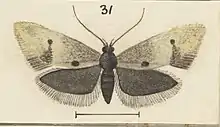Tingena idiogama
Tingena idiogama is a species of moth in the family Oecophoridae.[2] It is endemic to New Zealand and has been observed on the slopes of Mount Taranaki. Its preferred habitat is native subalpine scrub and adults are on the wing in January.
| Tingena idiogama | |
|---|---|
 | |
| Male lectotype | |
| Scientific classification | |
| Domain: | Eukaryota |
| Kingdom: | Animalia |
| Phylum: | Arthropoda |
| Class: | Insecta |
| Order: | Lepidoptera |
| Family: | Oecophoridae |
| Genus: | Tingena |
| Species: | T. idiogama |
| Binomial name | |
| Tingena idiogama | |
| Synonyms[2] | |
| |
Taxonomy
The species was first described by Edward Meyrick in 1924 using specimens collected at Mount Taranaki in January and named Borkhausenia idiogama.[3] George Hudson discussed and illustrated this species in his 1928 book The butterflies and moths of New Zealand also under the same name.[4] In 1988 J. S. Dugdale placed this species in the genus Tingena.[2] The male lectotype specimen, collected at Mount Taranaki is held at the Natural History Museum, London.[2]
Description

Meyrick described this species as follows:
♂♀. 15–16 mm. Head and thorax bronzy-grey, orbits in ♂ paleyellowish. Palpi grey, in ♂ suffused pale-yellowish towards base, apex of second joint whitish. Antennal cilation of ♂ 1. Abdomen dark grey, in ♂ anal tuft and exserted genitalia whitish-ochreous, in ♀ a short whitishochreous scale-tuft beneath from praeanal segment, ovipositor exserted, filiform. Forewings light grey, irregularly and suffusedly irrorated ochreous-whitish or light yellow-ochreous, especially posteriorly, a few scattered dark-grey scales; plical stigma blackish-grey, beneath it in ♀ an oblique spot of whitish suffusion; an inwardly-oblique streak of dark-fuscous suffusion from tornus, its apex indicating second discal stigma: cilia pale grey, suffusedly mixed or mostly suffused pale ochreous-yellowish. Hindwings dark grey; cilia grey.[3]
Hudson stated that this species is variable in appearance in particular its discal markings on the forewings.[4]
Distribution
This species is endemic to New Zealand and has been found on the lower slopes of Mount Taranaki.[1][4]
Behaviour
The adults of this species are on the wing in January.[4]
Habitat
This species prefers subalpine scrub habitat.[4]
References
- Gordon, Dennis P., ed. (2010). New Zealand inventory of biodiversity: Kingdom animalia : chaetognatha, ecdysozoa, ichnofossils. Vol. 2. p. 462. ISBN 978-1-877257-93-3. OCLC 973607714. OL 25288394M. Wikidata Q45922947.
- John Stewart Dugdale (23 September 1988). "Lepidoptera - annotated catalogue, and keys to family-group taxa". Fauna of New Zealand. Department of Scientific and Industrial Research. 14: 102. doi:10.7931/J2/FNZ.14. ISSN 0111-5383. Wikidata Q45083134.
- E. Meyrick (1924). "Descriptions of New Zealand Lepidoptera". Transactions and Proceedings of the New Zealand Institute. 55: 661–662. ISSN 1176-6158. Wikidata Q110305498.
- George Vernon Hudson (1928), The butterflies and moths of New Zealand, Illustrator: George Hudson, Wellington, p. 266, LCCN 88133764, OCLC 25449322, Wikidata Q58593286
{{citation}}: CS1 maint: location missing publisher (link)